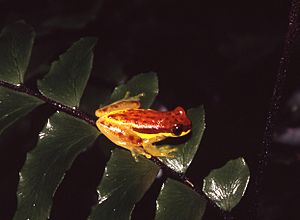Dendropsophus rhodopeplus facts for kids
Quick facts for kids Dendropsophus rhodopeplus |
|
|---|---|
 |
|
| Conservation status | |
| Scientific classification | |
| Synonyms | |
|
The red-skirted treefrog (scientific name: Dendropsophus rhodopeplus) is a small frog that belongs to the Hylidae family, also known as the treefrog family. These interesting frogs are found in the upper part of the Amazon Basin. This huge area covers parts of several South American countries. You can find them in Bolivia, Brazil, Colombia, Ecuador, and Peru.
Contents
Meet the Red-Skirted Treefrog
The red-skirted treefrog is a very common type of frog. It lives in many places across its home range. These frogs are often found in both old and new tropical rainforests. An old, or "primary," rainforest is one that has not been disturbed much by humans. A "secondary" rainforest is one that has grown back after being cleared or damaged.
Where Do They Live?
Red-skirted treefrogs make their home in the warm, wet tropical rainforests of the Amazon. This region is known for its amazing variety of plants and animals. The frogs live high up in the trees and bushes. They are well-suited for climbing with their special toe pads.
Their Rainforest Home
These frogs need water to live and to have their babies. They gather near different types of water bodies. This includes ponds that are always there, called "permanent ponds." They also use ponds that appear only at certain times, like after heavy rain. These are known as "temporary ponds." They also use swamps, which are wet, marshy areas. These wet spots are perfect for them to find food and lay their eggs.
Family Life: Breeding
When it's time to have babies, red-skirted treefrogs head to these ponds and swamps. The female frogs lay their eggs in the water. The eggs hatch into tadpoles, which are baby frogs that live in the water. They slowly grow and change into adult frogs. This process is called metamorphosis.
Are They Safe?
The red-skirted treefrog is currently considered a "Least Concern" species. This means that its population is stable and it is not in danger of disappearing. This is good news for these colorful little frogs. They play an important role in their rainforest homes.
Images for kids
See also
 In Spanish: Dendropsophus rhodopeplus para niños
In Spanish: Dendropsophus rhodopeplus para niños



